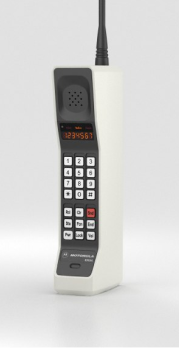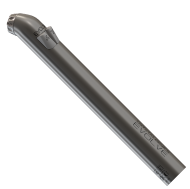Why take the risk?
For decades, the biggest change to air water syringes was adding a single-use air water syringe tip. Current cleaning methods for the air water syringe is covering your dental syringes in plastic and a quck wipe down with high-level disinfectants. Unfortunately, air water syringes are never heat-sterilized. Why? The design is outdated. The air water syringe system is the most used item in the dental practice. Should a patient feel comfortable with a device that is used on every patient and has never been heat-sterilized? Would you?
Public trust in dental health
What if patients were informed of the dangers presented by this high-use, semi-critical dental device? Most air/water syringe systems do not comply with CDC, ADA, FDA, or OSAP recommended device sterilization standards in today's dental office. There are many globally documented cases of dental cross-infection involving dental offices. These occurrences had enormous impact on patient lives, dental practices, and the communities where they occurred.
Dental Infection Control Updates


Department of Health
and Human Services FDA
FDA Dear Doctor Letter
Dear Doctor:
This is to notify you that the Food and Drug Administration (FDA) recommends that reusable dental handpieces and related instruments (such as air/water syringes and ultrasonic scalers) be heat sterilized between each patient use. Handpieces that cannot be heat sterilized should be retrofitted to attain heat tolerance.

Center of Disease Control
CDC Recommendations
2008 CDC
Dental Instruments
Scientific articles and increased publicity about the potential for transmitting infectious agents in dentistry have focused attention on dental instruments as possible agents for pathogen transmission207, 208. The American Dental Association recommends that surgical and other instruments that normally penetrate soft tissue or bone (e.g., extraction forceps, scalpel blades, bone chisels, periodontal scalers, and surgical burs) be classified as critical devices that should be sterilized after each use or discarded. Instruments not intended to penetrate oral soft tissues or bone (e.g., amalgam condensers, and air/water syringes) but that could contact oral tissues are classified as semicritical, but sterilization after each use is recommended if the instruments are heat-tolerant
… Heat-tolerant alternatives are available for most clinical dental applications and are preferred43.
8. Management of Equipment and Surfaces in Dentistry
a. In addition, after each use, sterilize dental instruments that are not intended to penetrate oral soft tissue or bone (e.g., amalgam condensers, air-water syringes) but that might contact oral tissues and are heat-tolerant, although classified as semicritical. Clean and, at a minimum, high-level disinfect heat-sensitive semicritical items. Category IA. 43, 209-211
Guideline for Disinfection and Sterilization in Healthcare Facilities, 2008, page 91
Summary of Infection
Prevention Practices in
Dental Settings
BASIC EXPECTATIONS FOR SAFE CARE
Because the majority of semicritical items in dentistry are heat-tolerant, they should be sterilized using heat.
If a semicritical item is heat-sensitive, the DHCP should replace it with a heat-tolerant or disposable alternative
Special Considerations
Dental Handpieces and Other Devices Attached to Air and Waterlines
Heat methods can sterilize dental handpieces and other intraoral devices attached to air or waterlines (246,275,356, 357,360). For processing any dental device that can be removed from the dental unit air or waterlines, neither surface disinfection nor immersion in chemical germicides is an acceptable method.
2003 MMWR, Guidelines for Infection Control in Dental Health-Care Settings — 2003 , page 30Recommendations
CDC Guidelines, FDA, OSAP and ADA recommedations provided to help ensure the dental office is safe for its dental health care providers and patients. Our goal is to help reduce the chances of cross-contamination in the dental office.

USA
Recommendations

Canada
Recommendations

United Kingdom
Recommendations

Australia
Recommendations
Research Studies
Learn more about the research studies pertaining to reusable versus disposable air water syringe tips and infection control studies of the air water syringe.
Air Water Syringe
-
Quintessence International: The air-water syringe: contamination and disinfection
1989 Dec;20(12);911-16
-
Scientific Reports: High-volume evacuation mitigates viral aerosol spread in dental procedures
2023 Nov 3;13(1);18984
-
PLOS ONE: A clinical observational analysis of aerosol emissions from dental procedures
2022 Mar 10;17(3);e0265076
-
IntechOpen: Infection Control in Dentistry and Drug-Resistant Infectious Agents: A Burning Issue. Part 2
2018 Nov;10.5772/intechopen.81494
-
British Dental Journal: Nosocomial transmission of methicillin-resistant Staphylococcus aureus via the surfaces of the dental operatory
2006 Sep 9;201(5);297-300
-
Rev Gaúcha Odontol: Changes in dental practice in times of COVID-19: review and recommendations for dental health care
2021;Odontol:69
-
Journal of the American Dental Association: Using Biological Indicator to Detect Potential Sources of Cross-Contamination in the Dental Operatory
1998 Nov;129(11):1567-77
-
Journal of the American Dental Association: Aerosols and splatter in dentistry. A brief review of the literature and infection control implications
2004 Apr;135(4):429-37
-
Journal of Clinical Pediatric Dentistry: Staphylococcus Aureus Contamination in a Pediatric Dental Clinic
2009 Fall;34(1):13-18
-
European Journal of Dentistry: Disinfectants Used in Stomatology and SARS-CoV-2 Infection
October 27, 2020 DOI 10.1055/s-0041-1724154
-
Journal of Applied Oral Science: Dynamics of the seasonal airborne propagation of Staphylococcus aureus in academic dental clinics
2018 Apr 5;26 e:20170141
-
Brazilian Journal of Oral Sciences: Isoenzyme genotyping and phylogenetic analysis of oxacillin-resistance Staphylococcus aureus isolates
2017 Dec; Vol.16
-
Journal of Periodontology: Demystifying the mist: Sources of microbial bioload in dental aerosols
2020 Sep;91(9):113-1122
Air/Water Syringe Tips
-
Australian Dental Journal: Efficacy of air/water syringe tip sterilization
2014; 59: 87–92
-
The Dental Advisor: Reusable versus Disposable Air/Water Syringe Tips
Number 13 - June 2012
-
EJPRD: Effectiveness of Disposable (Single-use) Tips for Dental Air-water Syringes
doi: 10.1922/EJPRD_1440Edwards05
-
Compend Contin Educ Dent: Rationale for using single-use disposable air/water syringe tips.
2000 Feb;21(2):176
-
Swiss Dental Journal: Cost comparison of reusable and disposable air/water syringe tips in a large French teaching hospital
VOL 128 2018
Aerosolization
-
Journal of Dentistry: A systematic review of droplet and aerosol generation in dentistry
105 (2021) 103556
-
Clinical Oral Investigations: Influence of flow rate and different size of suction cannulas on splatter contamination in dentistry: results of an exploratory study with a high‐volume evacuation system
(2022) 26:5687–5696
-
JIDAM: AEROSOL AND DENTISTRY IN COVID ERA
Vol:7/Iss:3/Pages91-95/July-Sep2020
-
PLOS ONE: A scoping review on bio-aerosols in healthcare and the dental environment
May 22, 2017
-
Rwanda Medical Journal: Effective and practical recommendations to dental team when providing dental services in the era of COVID-19
Vol.79,no.2,p.55-64,2022
-
European Journal of Dentistry: COVID-19 Pandemic and Role of Human Saliva as a Testing Biofluid in Point-of-Care Technology
Vol.14 No.S1/2020
Sterilization / Decontamination
-
Rev. Latino-Am. Enfermagem: Efficacy and effectiveness of alcohol in the disinfection of semi-critical materials: a systematic review.
2015 July-Aug:23(4):741-52
-
NCBI Bookshelf: Dental Infection Control
Bookshelf ID:NBK470356
Air Water Syringe - Other
-
British Dental Journal: The detection of blood on dental surgery surfaces and equipment following dental hygiene treatment
22 January 1994
-
Journal Dental Hygiene Science: Survey of Staphylococcus epidermidis Contamination on the Hands of Dental Hygienists and Equipment Surface of Dental Clinics
Vol.17 No.6 2017, ISSN 2233-7679
-
The Open Dentistry Journal: COVID-19 in Dental Practice: Transmission Risk, Infection Control Challenge, and Clinical Implications
2020,14,348-354
Time to upgrade
The same air/water syringes that have been used for over 30 years are still being used today. The CDC, ADA, FDA and OSAP all recommend that this semi critical device should be removed between patients to be heat-sterilized. The problem is, once installed, current air/water syringes are never removed to be heat-sterilized. This makes the air/water syringe non-compliant with leading health authorities.
1988
In 1988, this is what your cell phone and air/water syringe looked like.
2020
Over the last 32 years, your cell phone made drastic improvements. In that same time your air/water syringe never changed.
The One and Only Total Solution
CrystalGenics Evolve was designed with the purpose of resolving key infection control issues.
Learn MoreMake the Switch
It’s time for change. Replace your air/water syringes with those that meet current guidelines & patient safety demands.







